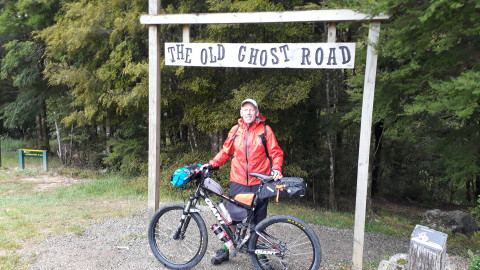
By Sarah Bennett
OPINION: Talk about right time, right place. Former prime minister John Key is at a job summit early in 2009 when an attendee bends his ear about the potential of recreational cycle trails.
Nek minnit, there's $50 million government bucks in the bank to build a continuous cycleway running the length of the country.
And so Sir John's name will forever be synonymous with one of the most significant recreational assets created in New Zealand in my lifetime.
Not so well known are names like Rod Peirce, Phil Rossiter and Glyn Wooller, all of whom had new shared-use trails in their sights well before a national cycleway was mooted.
By the end of 2012, the first ten Great Rides of the New Zealand Cycle Trail (NZCT) were open to riders. There are now 22, spread throughout the country from Northland to Southland. So what happened to the idea of a continuous route?
Such grassroots grafters rounded up council and other community funding that more than matched Key's $50 million, along with countless volunteer hours in trail-cutting, hut-building, trailside planting, pest-trapping and more besides.
Creating a cycleway the length of the country was deemed too big a mountain to climb, logistically and financially. That's hardly surprising. It's challenging enough to keep our state highway network open let alone 3000km of cycleway, too.

A continuous trail would also bypass many of the country's most popular sights, lessening its visitor appeal and in turn the potential to create jobs through increased tourism.
Establishing trails in more remote and unknown corners offered a chance to repurpose historic pathways such as railway corridors, bush tramways and pack tracks. This has restored many a relic, revived local history, and helped people discover it.
The government's 2016 NZCT Evaluation Report presents persuasive data on the economic benefits of the trails, but falls short of quantifying what I'd wager are wide-ranging and substantial social and environmental benefits for local users, surrounding communities, and the nation as a whole.

I've seen this contribution manifest in so many ways, in so many places.
Lee Slater and I have ridden all 22 Great Rides, most more than once. This has taken us to Seddonville, Matahiwi, Kumara, Puketapu, Athol and heaps more out-of-the-way places reaping genuine and sustained benefit from having a trail tootling past.
Other towns to have reaped rewards are Kaikohe and Kawakawa on Northland's Pou Herenga Tai/Twin Coast Cycle Trail.
According to trail manager Adrienne Tari, the benefits have spread further out. "Even the little town of Okaihau is flourishing. We've got a long way to go but we're confident we're on the right track."
Over the last decade, Lee and I have seen the Great Rides bed down and consolidate as a national asset with a recognisable and respected identity, much like DOC's Great Walks.
The network is also extending, with the latest opening the Hauraki Rail Trail's extension from Te Aroha through to Matamata, the home of Hobbiton.
The Great Rides are still in relative infancy and – despite ongoing government funding – rely heavily on their local communities to thrive.
Making this more challenging is the false impression held by many overseas visitors that the NZCT is a continuous national cycleway despite excellent official guidance on what the offering actually is.
Often arriving poorly researched due to a lack of cycle-touring-specific information, would-be tourers find themselves on busy highways where they put both themselves and other road users at risk.

Not all highways are equal, of course. Those in and out of our main cities have an average traffic movement of more than 25,000 vehicles a day, but the Forgotten World Highway (SH43) has around 500 vehicles a day travelling at around 70kmh.
The NZCT plays a pivotal role in keeping all road users safe.
Not only do the 22 Great Rides provide predominantly off-road routes taking in many places our visitors want to see, they are now complemented by the NZCT's growing network of Heartland Rides that provide the safest possible touring routes, primarily on scenic back roads.
The most recent addition is the Southland Traverse, a 104km route between Mossburn and Invercargill. Planned to open late this year, the Hunua Heartland Ride will stretch from Clevedon to Kaiaua.
The Heartland Rides are designated by NZTA according to rigorous criteria assessing traffic volumes and shoulder space.
NZTA is also working out where shoulder widening is needed, not just for people on bikes, but also horses, tractors, and broken-down cars. Shoulder space also reduces run-off-road crashes by 30 per cent.

Highwayside pathways are also an increasing part of the picture. The SH1 rebuild north of Kaikoura, for example, has factored in 11km of shared-use trail forming part of the proposed 200km Whale Trail from Picton to Kaikoura.
Turns out, the dream of a safe, continuous cycling route through New Zealand is alive and well.
And maybe we're actually closer than we think.
Late last year, five retirees from Whangarei rode the length of the North Island on ebikes, following the Kennett Brothers' 'Tour Aotearoa' route. Stretching from Cape Reinga to Bluff, the route traverses Great Rides, Heartland Rides and other quiet byways for an intensely scenic 3000km journey with minimal highway riding.
Rider Paul Carey was amazed at how few cars there were along the way. 'All in all, it felt incredibly safe,' he said.

Before we talk about banning cyclists from highways, we should probably put a bit more effort into educating visitors about the best routes and alternatives.
Apparently, we also need more education around shared use. As it is, bike riders have been using our main highways since 1869, 30 years before the first car arrived.
Bike riding is part of our culture.
